- Home
- Encyclopedia
- Gathering The Tribes: The Cheyennes Come Togeth...
Gathering the Tribes: The Cheyennes Come Together after Sand Creek
The Tongue River in northern Wyoming must have been as beautiful as it is now when George Bent saw it in 1865, curving under cottonwoods in early May, the grass thickening on its banks and the trees sending out their first green shoots. Nowadays, irrigated hay fields and the hamlets of Dayton and Ranchester, Wyo. lie along the river. In May of 1865, however, one stretch of it was packed with human beings. That month, there was as large a town on the Tongue as that river has ever seen.
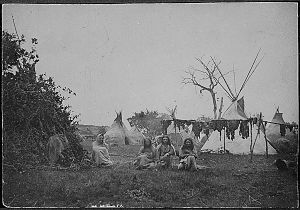
The town was made of tipis, not houses, and so in historical accounts it’s called a village. But it was a town, with nine or ten thousand people, a town council and a police force, horse corrals and big pony herds stretching beyond its edges in all directions.
If George Bent had climbed a hill, he would have seen a town in three parts. Furthest down the river was a group of around 1,000 tipis, pitched in no particular pattern. These belonged to the Oglala Lakota people, called Sioux by their enemies. A family of six or eight people lived in each tipi. Furthest up the river was a smaller group, perhaps 200 lodges. These belonged to Arapaho people. In the middle was a middle-sized group, much different from the others. Its 600 or so tipis were arranged in a huge circle, with a gap in the circle open toward the mountains and the northwest. These were George Bent’s people, the Cheyenne. About half of these tipis were made of buffalo hide, and beautifully painted. The rest were canvas. In the middle of the circle was a large open area, with two tipis pitched side by side at its center.
As the sun rose, smoke began to rise from cooking fires and people started breakfast. Dogs barked; a breeze rustled the grass and the new cottonwood leaves. A few people, talking sleepily, emerged from flaps at the tipis’ round doors, stepped through, and headed down to the river to wash. Others headed out beyond the last tipis to check on their horses. War had brought them here, but for now things were peaceful. There was time at night for dancing, drumming, singing, and a whole lot of visiting, and time for sleepy mornings afterward. Everyone had a lot of catching up to do. George Bent was 22 years old, and he was having the time of his life.
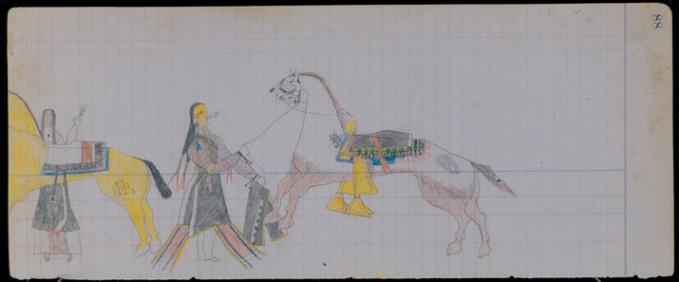
George’s mother was Owl Woman, daughter of White Thunder, who as Keeper of the Sacred Arrows was perhaps the most important person among the Southern Cheyenne. She had died when George was four years old, and he had been raised by her sisters, his aunts Island and Yellow Woman. George’s father was William Bent, a white man and the most important Indian trader on the southern plains. In the lodges of his mother and his aunts, and on the Great Plains stretching in all directions, George learned the skills that any Indian boy learned: how to hunt, how to ride, how to listen. William Bent was from a wealthy St. Louis trading family, and came west with his brothers in the 1820s. They trapped in the mountains with the Ashley men for a season or two, but soon realized there was more money to be made trading. In 1832 they built Bent’s Fort on the Arkansas River in what’s now southeastern Colorado, and ran their businesses from there. George grew up in lodges near the fort, and saw his father daily. From the time he was born, then, he was part of both worlds, the Indian and the white. All his life, he kept having to choose between them.
His father sent George east to Missouri when he was eleven. In Westport, now called Kansas City, George attended Nathan Scarritt’s Western Academy, where he learned reading, writing, arithmetic, Greek, and Latin. Three years later he moved to St. Louis. Briefly he attended a Catholic boarding school, and then something like a high school called the Webster College for Boys. And Robert Campbell, an old friend of his father’s, one of the Ashley-Henry partners in the early fur trade, became George’s legal guardian. The old man looked in on him from time to time and made sure he was doing all right.
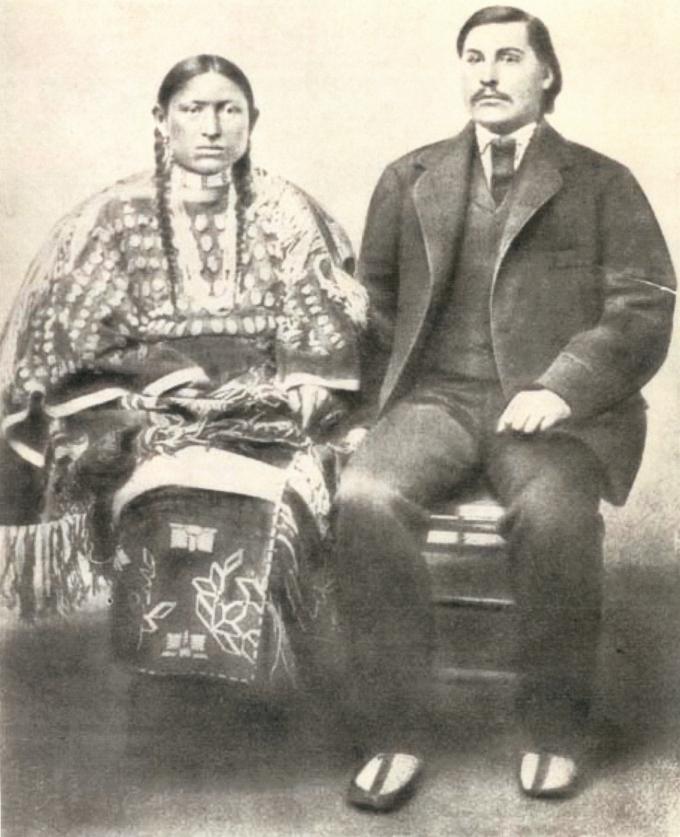
The Civil War broke out when George was 17. Missouri was a slave state. Though it did not secede from the Union, many of its people had strong sympathies with the Confederate cause. George and his friends joined a local cavalry militia that was absorbed into the Confederate Army. Later he switched to the horse artillery, particularly dangerous work. To see where to aim their cannons during smoky, chaotic battle the soldiers had to expose themselves in plain view to the enemy’s fire. It was a bloody business — war and killing on a scale unlike anything George had seen or imagined as a boy among the Cheyenne. After more than a year, fighting in battles in Missouri, Arkansas, and Mississippi in which a fifth of the men on both sides were often killed or wounded, George had had enough. He said later he was out scouting one day in August 1862 — an odd thing for an artilleryman to do. More likely he deserted. He was soon captured by Union cavalry.
The prisoners were marched to St. Louis and locked in a prison that turned out to be the same Catholic boarding school he had attended years before. But George was in a cell only two days before Robert Campbell and George’s older brother, Robert Bent, both strong Union supporters, got wind of what had happened. George was allowed to sign an oath that he would never again fight against the Union, and he was released. He was 18. He headed home to the Arkansas River and his mother’s people, riding with his brother at the head of a Bent wagon train full of trade goods.
The plains had changed since he had left. His mother’s people, the Southern Cheyenne, were a part of the tribe that had moved south in the 1820s. It was to capture the trade of these people that the Bents had first built their fort on the Arkansas. In a big treaty near Fort Laramie in 1851, the Cheyenne and the Arapaho had jointly been guaranteed all the land between the South Platte and the Arkansas rivers — that is, most of what are now eastern Colorado and a lot of western Kansas. It seemed like plenty of room. The tribes were happy to accept.
Then gold was discovered at Pike’s Peak in 1859, and Denver sprang up nearby. The country began filling up with white people. Small fights followed, then bigger ones. The regular U.S. Army troops who had been stationed on the plains were sent east to fight in the Civil War, and the new Colorado Territory raised its own troops to replace them. These men, barely soldiers at all, grew more and more angry with the Indians, who could move so fast and were so hard to catch. Late in November 1864, George and his brother Charlie were visiting Cheyenne friends and cousins at a village on Sand Creek, a tributary of the Arkansas in southeast Colorado. The village, led by a peaceful chief named Black Kettle, was waiting for news on some recent peace negotiations. The Colorado troops attacked, however, killed everyone they could, and scalped and cut up the bodies. About 135 people were killed, including large numbers of children and women — about a fifth of the people in the village. The rest put up enough of a fight to get away.
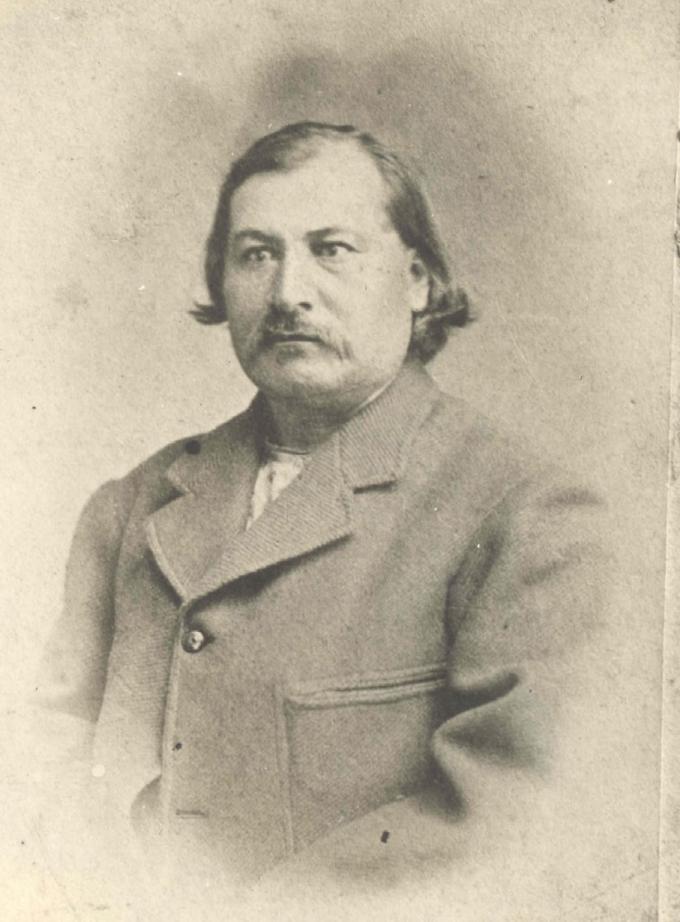
Word of the slaughter spread quickly among the tribes. The Cheyenne, the Lakota, and the Arapaho were deeply angry. Those who had been uncertain whether peace or war was the best course were forced to choose. Some, including Black Kettle, stayed peaceful. They argued there were too many whites now for the tribes ever to win a real victory. Most, however, felt so wronged they hardly cared. The Cheyenne and Arapaho on the southern plains agreed they would move north, and join their friends and cousins the in the country along the Tongue, Powder and Little Powder rivers in what’s now northeast Wyoming and southeast Montana. They would move right away, in the middle of winter. This was big, open country they were heading for, grassy in the summertime, rich in buffalo year round and empty of white people. They knew they would be welcome there. It was a center of power. The Southern Cheyenne sent messengers to find the people on the Powder and tell them they were coming.
Along the way, they made war. Bent was with the Cheyenne warriors when they attacked Julesberg, a big stage station, warehouse and store on the South Platte River in northeast Colorado. There was an Army post nearby. The Cheyenne were able to lure the soldiers out of the fort, and kill and scalp 18 of them before the rest scrambled back in. The soldier deaths made the warriors and their families feel better. Then the Indians looted the warehouse and store. They attacked ranches and other white travelers and troops along the road between Julesberg and Denver. Some of these troops were carrying Indian scalps from Sand Creek in a small suitcase. Again the Cheyennes and Lakotas attacked Julesberg, burning the store this time, and moved on north with all their people. Again they attacked the soldiers at Mud Springs, on the North Platte. And at last the people — with their families, their lodges, their horse herds, everything they owned — headed off through the Sand Hills of Nebraska toward the Powder River.
Soon they met the messengers they’d sent out earlier. The Oglala Lakota and the Northern Cheyenne had turned up in big camps on the Powder. The Arapaho were on the Tongue, further west. The messengers had brought several of their northern cousins back with them.
The two branches of the Cheyenne had been living apart for nearly 40 years now. Bent was surprised at how different they looked. Instead of blankets, the northerners wore buffalo robes. Instead of cloth leggings, they wore buckskin ones. They wrapped their braids in red-painted strips of buckskin, and wore strangely cut crow feathers in their hair. Their speech was different, with more Lakota words in it and a different accent. When at last the southerners arrived on the Powder, they found the Oglala and Northern Cheyenne still lived in buffalo-hide tipis. Down south, close to traders like the Bents, it was easier for the tribes to trade for canvas tipi covers. The northerners “looked much wilder than any of the southern Indians,” Bent remembered years later, “and kept up all the old customs, not having come much in contact with the whites.”
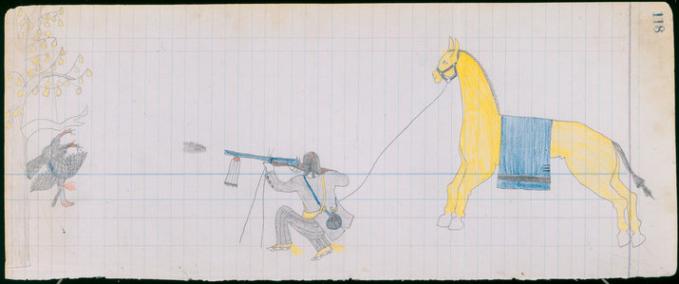
The camps moved camp often through the winter, following the buffalo and making sure their horses had fresh grass. While the older men talked endlessly about what the tribes should do, there was time now, far from whites and far from war, for everyone else to visit and socialize. The northerners were great dancers, great drummers, great singers. One night a party of Crow warriors sneaked in and stole some Cheyenne horses. Next day the Cheyenne caught up with four of their enemies, and killed and scalped them on the spot. Perhaps because the Crow men wore their hair very long, the Cheyennes cut the scalps in half and returned home with eight trophies of their victory. The scalp dancing began that night and went on every night for three weeks. The drumming scared the buffalo away. Everyone agreed the buffalo enjoyed the singing, but were frightened off when the drums got too loud. When they found the buffalo again, the men’s group whose turn it was that week to police the villages made sure the people sang and danced only. No drums allowed.

In May when the new grass came, there was more feed for the horses and the people did not have to move so often. At last all the tribes—Cheyenne, Oglala Lakota and Arapaho—camped together and made their big town on the Tongue River.
And every time the Cheyenne camped, as we have seen, they pitched their tipis in a circle. Different clans would camp together in the arc. An opening was left in the circle in the direction they expected to be traveling next. In the middle of the circle were two special tipis. Hung inside one tipi was the sacred Medicine Hat, a buffalo-horned headdress together in a bundle with other things sacred to the Northern Cheyenne. Hung inside the other were the four Sacred Arrows, sacred to the Southern Cheyenne, which had been given to the people centuries before by the great spiritual leader Sweet Medicine. Each of these bundles of sacred things had a person, a keeper, whose duty it was to watch over them all the time. As long as that person was a good person, honest, smart, modest and open, things would go well for the people.
That summer the wars started up again, and the tribes attacked Platte Bridge Station and killed Lt. Caspar Collins. But the winter and spring of 1865 were long remembered by George Bent and by all the Cheyenne as a time of great power, when the people were together and the two sacred tipis could be pitched side by side.
Resources
Primary Sources
- Hyde, George E. A Life of George Bent, Written from his Letters. Edited by Savoie Lottinville. Norman: University of Oklahoma Press, 1968. George Bent died in 1916. For a decade or more before that Hyde corresponded with him and interviewed him many times, and wrote this book in the 1930s out of the letters. But the book did not find a publisher until the 1960s. It’s written in the first person, as though George were speaking himself, and so I call it a primary source here—though it isn’t, exactly.
- Johnson, Hervey. Edited by William E. Unrau. Tending the Talking Wire: A Buck Soldier’s View of Indian Country, 1863-1866. Salt Lake City: University of Utah Press, 1979. Johnson wrote 100 vivid letters home to his mothers and sisters in Ohio during the three years he served with Casper Collins’s regiment in Wyoming. Maybe the best book around for a sense of the soldier’s side of the Indian wars.
Secondary Sources
- Halaas, David Fridtjof and Andrew E. Masich. Halfbreed: The Remarkable True Story of George Bent, Caught between the Worlds of the Indian and the White Man. Cambridge, MA: Da Capo Press, 2002. An excellent, fast-moving, scholarly biography with intelligent attention given to Bent’s life after the Indian wars as well as before. This book is in many Wyoming libraries.
- Hungrywolf, Adolf. The Tipi: Traditional Native American Shelter. Summertown, TN: Native Voices Book Pub. Co., 2006. Lots of historical photos of tipis, with commentary on how tipis were made, used, changed over time and varied from tribe to tribe. This book is in many Wyoming libraries.
Online
- See an account of conflicts now going on over history, education, religion, and money on the Northern Cheyenne Reservation in Montana.
- See Arrow's pictures and other ledger art drawn by Plains Indians around the time they gathered on the Tongue River and slightly afterward. See more ledger art.
- Contrast Col. Chivington’s report of the fight at Sand Creek with George Bent’s version.
- See more contemporary accounts of the Sand Creek Massacre here.
- See a detailed timeline of events important to the tribes on the northern Great Plains, with many useful links.
Field Trips
- George Bent doesn’t give enough information to say for sure, but it’s possible the tribes in May, 1865, camped at or near the place on the Tongue River where the Arapahos were attacked the following October by troops under General Patrick Connor. This spot is now a city park and picnic area — with a historical marker about Connor’s attack — in Ranchester, WY.
- For an excellent feel for Plains Indian life in the 1800s and early 1900s, visit the Plains Indian Museum at the Buffalo Bill Historical Center in Cody.
- Battle sites important to the Indian Wars in Wyoming and southern Montana are well known and well managed. Moving north to south, these include the Little Bighorn battle site near Crow Agency, Montana; the Fetterman and Wagon Box fight sites and Fort Phil Kearny near Story, Wyoming; Fort Caspar in Casper, Wyoming; Fort Fetterman outside Douglas, Wyoming; and Fort Laramie.
- A different exercise would be to follow almost any Wyoming dirt road in summer until out of sight of any paved roads, gas wells, oil wells, power lines, pipelines, houses, haystacks, or irrigation pipes, and imagine the same spot 150 years ago. Such places are still easy to find.
